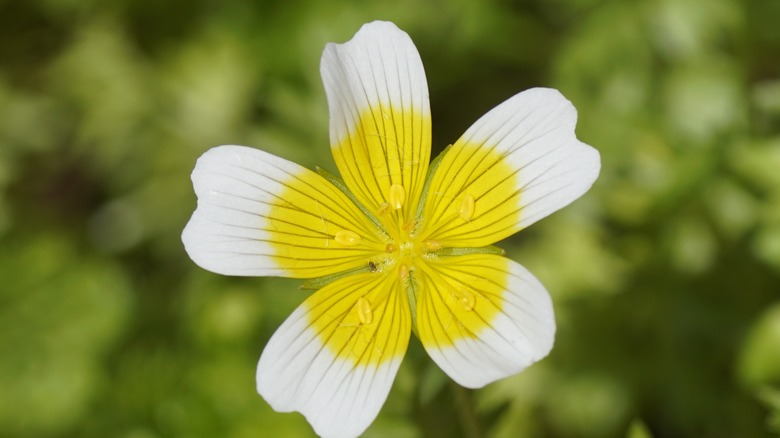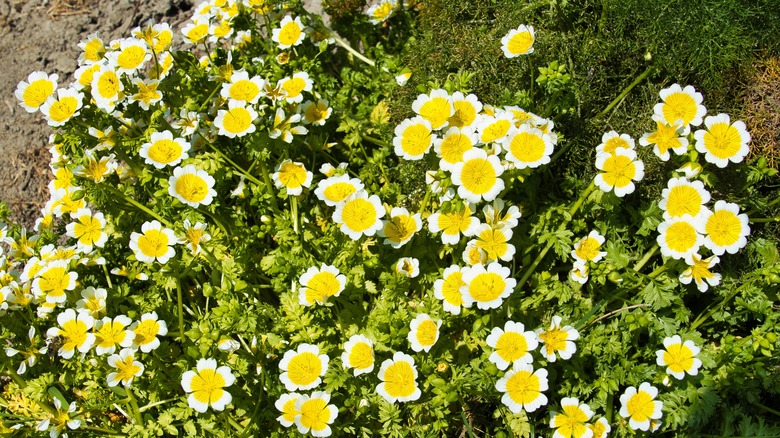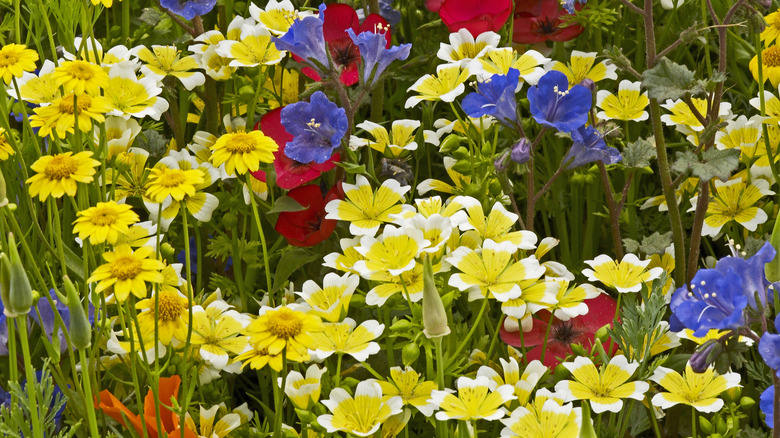Grow A Flowering Poached Egg Plant In Your Garden For All Of Its Benefits
While there are many plants that resemble the sun, there are far fewer that look like a sunny-side-up egg. If you're hatching a plan to add some "egg-citement" to your garden, then you can't go wrong with the poached egg plant. This little plant isn't just adorable and easy to grow — it also comes with some major benefits, as it is a huge hit with pollinators and other beneficial insects and is a great ground cover option.
Native to the West Coast of the United States, poached egg plants (Limnanthes douglasii), sometimes called meadowfoam, are annual flowers that grow well during summer months in USDA zones 2 through 12. Despite their name, not all subspecies of Limnathes douglasii have distinctive egg-like colorations. Some are more subtly colored and may have creamy-colored centers or boast an all-white or all-yellow color scheme. Regardless of their exact colors, poached egg plants are a must-have for gardeners in Oregon and California who want to grow native plants and are a great addition for gardeners throughout the United States who want to encourage beneficial insects to visit their yards.
Start poached egg plants from seed, and water them well
Poached egg plants can easily be started from seeds, which are readily available in seed catalogs and garden centers. While they can be started indoors, you can also directly sow these seeds into your outdoor garden as long as you wait until all danger of frost has passed. Find a full-sun location to sow your seeds. Then, lightly press them into well-drained soil with plenty of organic material, about 2 inches apart, and water them well. The seeds should begin to germinate within two to three weeks.
Once your poached egg plants have begun to grow, remember to fertilize them monthly with a balanced fertilizer to ensure the best blooms. They also need regular watering so their soil remains moist but not soggy. To keep the plants blooming prolifically, be sure to deadhead spent blooms. Since poached egg plants self-seed readily, consider allowing some plants to go to seed if you want poached egg plants growing in that area next season. You can also collect seeds and store them to sow again next spring.
Poached egg plants bring bees, butterflies, and hoverflies
The flowers of poached egg plants aren't just cute, they are also great companion plants as they attract beneficial insects, including nectar and pollen foraging varieties of bees,, butterflies, and hoverflies to your garden. They are even a useful food source for native bees like the blue orchard bee. Once in your garden, the bees and butterflies can help with pollination, while the hoverflies, which are harmless wasps and bee look-alikes, have larvae which feed on pesky aphids that might otherwise damage nearby plants like roses and hibiscus.
Another benefit of poached egg plants is their use as a living mulch or groundcover. Because they spread easily and seldom grow taller than 9 inches, they're ideal for the fronts of borders and can help to shade the roots of nearby plants. Poached egg plants are also long-blooming, providing you with long-lasting color and beauty for your garden. In some areas, they bloom from June all the way through to September.


